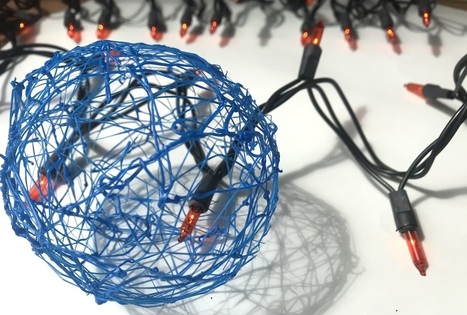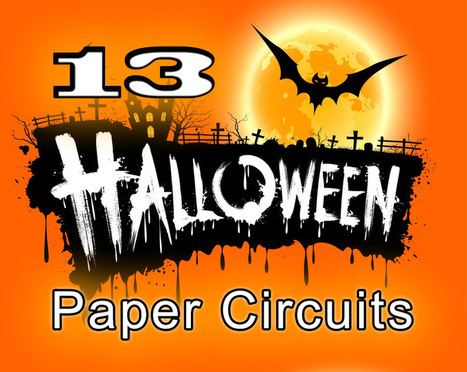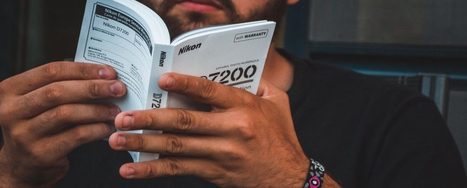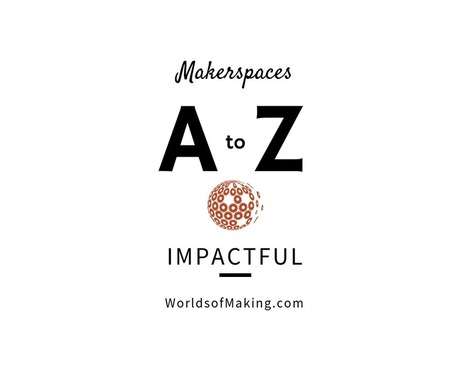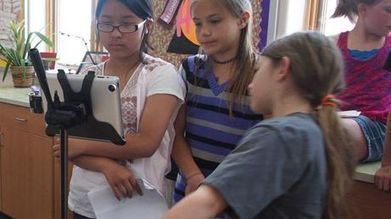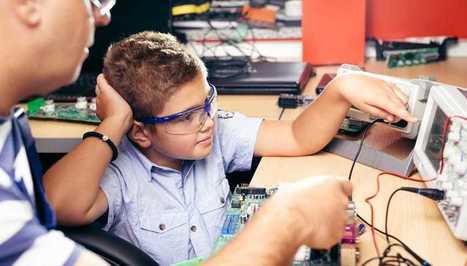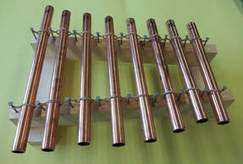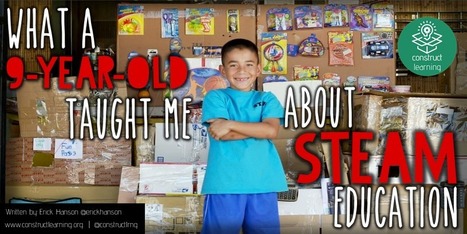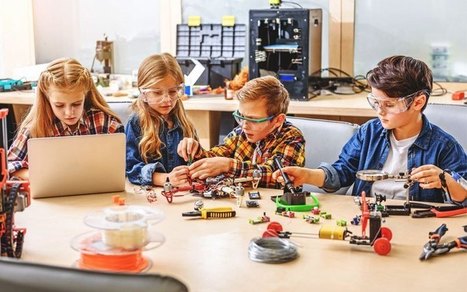 Your new post is loading...
 Your new post is loading...

|
Scooped by
John Evans
|
New technologies are continually hitting the market. Educators are always looking for the next innovative thing to bring into their classroom. Some of them don’t stand the test of time, but others show tremendous potential. One such innovation that is perfect for the art room is the 3-Dpen. It’s not just another device, but it is a new sculptural medium.
Learn how you can use 3-D pens in your art room to encourage critical thinking and problem solving while creating.

|
Scooped by
John Evans
|
Get into the Halloween “spirit” by creating these fun light-up paper circuit cards.
This project is not only fun but educational. You will learn how to create different kinds of conductive circuits using copper tape, LEDs and a coin cell battery.
Download the FREE Halloween project ebook using the link below. Ebook contains all 13 spooky paper circuit templates. Color them or print them on colored paper.
Happy Halloween !!

|
Scooped by
John Evans
|
I spend a lot of time thinking about Makerspaces.
These engaging spaces that bring creativity, tinkering, and exploration to our communities make me push the possibilities and potential of what these spaces and experiences can bring to our young people.
For me it is fun to think about all of the different elements we can add to our Makerspaces.
There can be duck tape, 3D printers, art supplies, recycled goods, old computer parts, wood, Makey Makey kits, Sphero’s, knitting needles and yarn, LEGO’s, playdough, wood, hot glue guns, fabric, paper, wire, and the list goes on and on.
Now think about this.
Ask yourself….

|
Scooped by
John Evans
|
What's the best 3D pen? Check out our buyer's guide to find the best 3D pens for kids, hobbyists, and artists.

|
Scooped by
John Evans
|
Open-exploration in a makerspace is a time when students can freely explore different tools and materials with little to no structure and minimal supervision. In a library makerspace, this often coincides with walk-ins, where students freely come in during the day to work in the makerspace. Of course, this doesn’t mean that the makerspace is available for open-exploration 24/7. Setting procedures and logistics will help students to know when it is available. You could allow for drop-ins only during certain time periods (before school and during lunch). You could incorporate open-exploration into what would usually be a more structured time, like an afterschool Makers Club. Like most things with makerspaces, there isn’t necessarily a right and a wrong way to do things. It’s about trying stuff out, experimenting, iterating and figuring out what will work best for your school and your students.
That being said, there are best practices you can put in place that will help things to run more smoothly.

|
Scooped by
John Evans
|
Do you know how to change the oil on your car? What about how to knit a scarf? Or how to make compost?
If you need some help with life’s little chores, the internet is full of guidance. But which sites should you head to when you need some advice? Here are 12 how-to sites that everyone needs to have saved in their bookmarks.

|
Scooped by
John Evans
|
Paper circuits are a fun way to learn the basics of electricity while seeing how circuits are created.
This project will show you how to create a paper circuit school bus with flashing lights using copper tape, an LED and a coin cell battery.
The switch in this project is known as a Single Pole Double Throw or SPDT. A single source of power goes to this switch and yet it can control two separate LEDs at different times. This switch will allow you to make the school bus lights flash on and off.

|
Scooped by
John Evans
|
Makerspaces that are impactful are not a new idea, in fact, I have written before about this Maker Care program, created by Islip, NY Library Media Specialist, Gina Seymour. Over the past year, I also have discovered the work of Steve Sostak and Aaron Moniz, of Inspire Citizens who through their Empathy to Impact approach, help infuse the United Nations Sustainable Development Goals, global competence frameworks, and media literacy into project-based inquiry, design thinking, curricular standards, language objectives, and 21st-century learning. With their work in mind, I launched a makerspace initiative in Nigeria, Making the SDGs, in partnership with my friend and colleague, Jacob Sule, which aims to empower and support students/youths in rural Nigeria to help to achieve the United Nations Sustainable Development Goals, through a network of makerspaces.

|
Scooped by
John Evans
|
Learning in the doing is learning in context. It’s the kind of learning that includes all the messiness and complexity of making something happen in the real world.

|
Scooped by
John Evans
|
Every year at Hollywood award shows, we see fantastic movies celebrated for their rich storytelling and dynamic performances. Your students can become moviemakers, too, thanks to some powerful apps for mobile devices. With these tools, your children can take videos and edit their work to make professional quality movies using iOS devices (iPads and iPhones) and Android tablets.
One good thing about this easy-to-use technology is that students can still use important English language arts skills like writing a narrative, planning a sequential story, and including key details when getting ready to make a movie. These apps can enhance the work that you are doing with children in the classroom and give them room to be creative storytellers.

|
Scooped by
John Evans
|
Does STEM scare you?
It scared me for a long time. I was that guy who put IKEA furniture together… backwards. When the oil light came on in the old Pontiac 6000 I used to drive, I thought it meant the car needed more gas.
I recently found myself at the helm of a Montessori Elementary schools’ new STEM program. Needless to say, I felt like a fish out of water. But as is the case with any new project I take on, I have realized, success is about 0.5% due to me and 99.5% the result of the team I put in place around me. Fortunately, I have two brilliant team members – one, a hippie science whiz who would give Bill Nye a run for his money and another, an easygoing, affable Canadian who could probably figure out how to reassemble a computer having never seen the inside of a CPU.
Together, we have slowly introduced STEM to elementary students within our brand new MakerSpace. And while it’s been slow going and we have made TONS of mistakes along the way, I believe we are starting to gain traction.
If you are new to STEM or are trying to figure out how to maximize the use of your new MakerSpace, here are five things to consider:

|
Scooped by
John Evans
|
Of all the learning trends of the past 20 years, one of the most sweeping and impactful has been the rise of the maker movement.
And that means that the aching rift between what people say they believe and where they put their money widened last week. After 15 years of inspiring millions of people to be creative and “make” something out of just about nothing, Maker Media, the company behind much of momentum, shut down due to financial shortfalls.
Now comes the challenge: Will those who believe in the power of “making” find a way to reinvent it?

|
Scooped by
John Evans
|
As the final project of the school year, I asked a group of my gifted 4th through 6th graders to design and prototype a new type of shoe. In a recent post from Idea U, Why Everyone Should Prototype (Not Just Designers), Chris Nyffeler, IDEO Executive Design Director, discussed the purpose and value of prototyping:
When we say prototype, that’s anything that gets the idea in your head into an artifact people can experience and offer feedback on.
You use prototyping to process the ideas themselves and to help you think through the idea better.
It’s not that you process your idea and then communicate it through a prototype. You actually use prototyping to process the ideas themselves and to help you think through the idea better.
Keep early prototypes quick and scrappy. By starting with tools that are familiar to you and easy to use, you can quickly create something tangible that will allow you to gather feedback and learn what’s working and what’s not.
|

|
Scooped by
John Evans
|
These are the English language drafts of our instrument build guides originally created for the Fundacion Mustakis in Chile
Get into the Halloween “spirit” by creating these fun light-up paper circuit cards.
This project is not only fun but educational. You will learn how to create different kinds of conductive circuits using copper tape, LEDs and a coin cell battery.
Download the FREE Halloween project ebook using the link below. Ebook contains all 13 spooky paper circuit templates. Color them or print them on colored paper.
Happy Halloween !!

|
Scooped by
John Evans
|
Make this littleBit powered inchworm at your school, library or makerspace. We have included a video and written tutorial with step-by-step instructions.

|
Scooped by
John Evans
|
Learning how to solder w/ proper soldering techniques is a fundamental skill every maker should master. In this tutorial, we outline the basics of soldering irons, soldering stations, types of solder, desoldering and safety tips. Whether you’re building a robot or working with Arduino, knowing how to solder will come in handy.

|
Scooped by
John Evans
|
I can’t stop thinking about Caine’s Arcade.
If you haven’t seen it, you gotta check it out. It’s a bit dated – 2012 is ancient history in the EdTech world – but to date, this YouTube video has over 8 million views. Caine’s Arcade is still inspiring people everywhere.
If you still haven’t seen it, then let me break it down for you. Caine, a nine-year-old boy hanging out at his dad’s auto parts store in a rough East LA neighborhood, had an idea to use the stuff lying around – mostly used cardboard – to create his own arcade. One particularly inspired customer stumbled upon it and…well, just go watch the video. Trust me, it’s worth your time.
I love this story because it reminds me about the power of STEM and how easy it can be to implement if you’re keeping your eye on the goal. When we educators aim to inspire and empower our students to do something great, we’ll find that often, we can deliver some life-changing learning experiences without breaking the bank on sophisticated robots and bleeding-edge technology.

|
Scooped by
John Evans
|
"Making is a dynamic and hands-on learning experience that directly connects with long-established theories of how learning occurs. Although it hasn't been a focus of traditional education or had a prominent place in the classroom, teachers find it an accessible, exciting option for their students.
The maker movement brings together diverse communities dedicated to creating things through hands-on projects. Makers represent a growing community of builders and creators—engineers, scientists, artists, DIYers, and hobbyists of all ages, interests, and skill levels—who engage in experimentation and cooperation.
Transferring this innovative, collaborative, and creative mindset to the classroom is the goal of maker education. A makerspace isn't about the latest tools and equipment. Rather, it's about the learning experiences and opportunities provided to students. Maker education spaces can be as large as a school workshop with high-tech tools (e.g., 3D printers and laser cutters) or as small and low-tech as the corner of a classroom with bins of craft supplies. Ultimately, it's about the mindset—not the "stuff.
In Learning in the Making, Jackie Gerstein helps you plan, execute, facilitate, and reflect on maker experiences so both you and your students understand how the knowledge, skills, and attitudes of maker education transfer to real-world settings. She also shows how to seamlessly integrate these activities into your curriculum with intention and a clearly defined purpose."

|
Scooped by
John Evans
|
"As their name suggests, laser cutters create patterns and designs by cutting into materials. A powerful laser beam is the source that melts, burns, or vaporizes the material.
Essentially, laser cutting is a fabrication process that uses a thin, focused, laser beam to cut and etch materials into custom designs, patterns, and shapes as specified by a designer. This non-contact, thermal-based fabrication process is ideal for several materials, including wood, glass, paper, metal, plastic, gemstone, and is capable of producing intricate parts without needing a custom-designed tool."

|
Scooped by
John Evans
|
What is a makerspace? What projects and materials do you recommend for a makerspace? Why are makerspaces becoming so popular in schools and libraries? These are just some of the questions we hear often. In order to help, we decided to put together a collection of our favorite makerspace resources and websites.
In this post, you will find over 101+ links to makerspace related articles, guides, checklists and more that will help you get started with hands-on maker education.

|
Scooped by
John Evans
|
In Gerry Irrizary’s maker lab (featured image), young designers use 3D printers to prototype sneaker insoles, fashion designer skateboards with laser cutters, and implement the latest strategies in user interface to plan new mobile apps.
The lab where teen dreams come to life is on the fourth floor of a city block-sized austere 1970s school building next to the New York City Police Department in Lower Manhattan. The lab is the heartbeat of digital design pathway at the Urban Assembly Maker Academy (@UAMakerNYC), a school founded in 2014 with support from the Carnegie’s Opportunity by Design grant program.

|
Scooped by
John Evans
|
After experimenting with 3D printing on tulle, I wanted to keep going. While trying to figure out earring designs, I decided to use string instead of tulle to see what would happen and it worked well 3D printing on string is super easy to do and has really fun results.
I can't find an example, but I feel like I've seen an anime or cartoon character that had earrings that just seemed to float off the ear and this would be a good way to accomplish that effect for cosplay.

|
Scooped by
John Evans
|
This morning kids were 3D printing some new designs. They were joined by a group working on a geometry problem. At lunch time, the Code Club worked on their snake robots (ironically coded in Python), then a team worked on unicorn designs. After the Engineering and Physics class, a group of kids worked on four panes that illustrate The Kite Runner.” Jayne Everson, Director of Robotics + Engineering and R+D Experience Lead at Beaver Country Day School summarized the eclectic forms of engagement experience on one day at the year-old Research + Design Center.
Nationally known for its forward-leading education, Beaver Country Day School released a Student Engagement Study today outlining the ways that big flexible spaces can unleash learning—in some expected and surprising ways.
To determine the impact of the Research + Design Center during its first year, three graduate students from the Harvard Graduate School of Education spent time interviewing, observing and surveying students and faculty. The study found that 95% of students understand topics better when learning in a collaborative, project-based space.
Replacing the old dark library, the school’s new 38,000 square foot Research + Design Center is a state-of-the-art innovation hub designed to promote student-driven learning. The Center hosts regularly scheduled classes, project teams, clubs and lots of drop-ins.

|
Scooped by
John Evans
|
This was a couple of years ago, when my kids were all still in elementary school, but since that time, I’ve seen this pattern more and more as they’ve gotten older: Every day, for the most part, information is delivered to them in some really basic way—usually PowerPoint—and the kids copy down what the teacher tells them to from the slides. Then they have some sort of worksheet where they’re basically regurgitating what was on those slides. After this cycle repeats four or five times, they have some kind of test. And that’s it.
This is not good. If we want our students to actually learn the facts and concepts and ideas we’re trying to teach them, they have to experience those things in some way that rises above abstract words on paper. They have to process them. Manipulate them.
To really learn in a way that will stick, they have to DO something.
|

 Your new post is loading...
Your new post is loading...
 Your new post is loading...
Your new post is loading...




